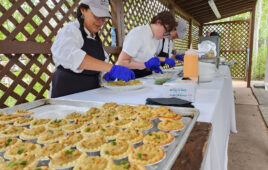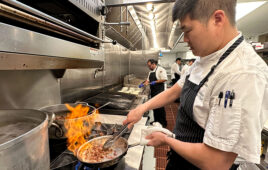
Mark Hamilton, Executive Chef, Paradise Valley CC
Taco Tuesday or penne pasta with meatballs? No need to decide; the options are plentiful for club staffers who are provided with discounted or fully funded meals as a paid benefit. And while chefs have many mouths to feed—from the grounds crew to upper management—they must work within a fixed budget to accommodate different dietary restrictions and varying palates.
For the following club culinarians, their experiences in the kitchen have prepared them well for employee meal production. Because of them, club personnel don’t need to consult or order from a menu to be guaranteed a meal that is delicious, nutritious and economical.
Managing Moving Parts
Experience has proven to be the best teacher for Executive Chef Mark Hamilton of Paradise Valley (Ariz.) Country Club. During his previous position at a larger club with multiple locations, he utilized a central commissary for employee meal production and transported food to various locations. But since this wasn’t a one-size-fits-all solution, he implemented another strategy.
“It was a challenge for the golf course maintenance workers to get to the clubhouses and eat within the allotted half-hour break time,” Hamilton explains, “so we gave them vouchers for lunch and had some local foods trucks drive onto the property to serve lunch on location.”
Such forward thinking has come in useful when managing the culinary team at Paradise Valley, where Hamilton has spent the last decade. Today, meal production is down to a science: prepared in the club’s main kitchen and served in a dedicated employee cafeteria. Hamilton writes the menus with his morning saucier who is also responsible for preparing the hot food. (His garde-manger department assembles the cold food for the salad bar.)
The right equipment is essential for keeping the employee meal program running smoothly, particularly since break times are limited. A warming cabinet is transportable and maintains the temperature of the back-up food. A three-compartment hot well and salad bar (filled with ice for colder items) are also in place, as is a soup warmer. On the beverage front, iced tea and coffee makers, along with ice water and lemonade dispensers, are at the ready.
Budgeting $3 per employee allows Hamilton to prepare meals that are both nutritious and flavorful. “We have a pretty diverse demographic that we are feeding daily,” Hamilton notes.
To give employees plenty of choices, he is sure to have fresh fruits, vegetables and salad greens as healthy meatless options, along with sliced deli meats and cheeses, tuna salad and bread in the salad bar/cold food lineup. On the hot side, menu mainstays are beef or chicken tacos for Taco Tuesday, lasagna, spaghetti and meatballs and chicken al fredo pasta. Other popular selections are casual fare like hamburgers, hot dogs, bratwurst and grilled chicken sandwiches, as well as roasted or BBQ chicken and baked cod, which Hamilton notes are easy to prepare from scratch. Pulled pork shoulder is another reliable, relatively effortless dish.
“The cooks at night put the pork in the smoker and slow cook it,” he explains. “When the morning cook comes in, he can simply shred it and have lunch for the employees produced pretty quickly.”
One essential element factored into all of Paradise Valley’s meals: maintaining the same level of excellence for staff lunches and dinners that member dining receives. Hamilton sees his program as a perk that should reflect the value of the club itself.
“Meals are offered as a benefit, so the care and quality of the food presented should really be a benefit [as well],” he says.

Christian Madsen, Executive Chef, Blythefield CC
Sustenance for the Staff
If the crew at Blythefield Country Club in Belmont, Mich., are like foot soldiers, then Executive Chef Christian Madsen is their fearless leader. He firmly believes that employee meal programs are an essential benefit. “
The adage that an army travels on its stomach is very true,” says Madsen, who Is beginning his second year at Blythefield.
While two previous stints at private and semi-private clubs have prepared him for creating meals for the masses, perhaps it is Madsen’s prior gig at a private hotel—where he provided daily meals for up to 800 staffers—that has proven its value. At Blythefield, he and his executive sous chef develop their menus together, and meals are served twice daily: at 11 a.m. and 4 p.m., so as not to overlap with dinner service. Managers provide Madsen with a forecast of the day’s attendance, which he consults when planning his menu.
“We make sure that associates have a salad option, protein, starch, vegetable and sometimes dessert when available,” he notes, adding that $2 per employee is factored into his budget.
Among the more popular menu items are comfort foods with familiar flavors, but Madsen likes to get creative using different seasonings, sauces and marinades. And while fried food may be an obvious choice for mass production, he is not willing to compromise on quality for the sake of convenience.
“Quality only comes by frying in small batches; we save those items for days that we are slower so we can monitor quality,” he notes.
During the busy season, kitchen staff typically preps a day in advance, so the food can go directly into the combi oven and heat to serve. Crowd-pleasing favorites, particularly among high school and college-aged summer hires, include chicken tenders and fries with dipping sauces; teriyaki chicken with coconut rice (click here for the recipe); carne asada tacos with traditional accompaniments, black bean and corn salad and Spanish rice; and penne pasta with tomato-basil sauce and mozzarella, garlic bread sticks and broccoli.
While designing a menu that factors in food allergies or intolerances—Madsen usually subs in a dish from the club’s main dining facility—he must also ensure that the selection reflects business-level standards. “This can be navigated with pre-organization of the menu,” he says. “We like to make sure everyone has a good, delicious option for their employee meal.”
In the kitchen, Madsen relies on his combi and convection ovens, along with the grill and stovetop, for employee meals. Food is served in the employee break room, which is outfitted with a common seating area, cafeteria-style table, microwave and refrigerator. Staff can also dine elsewhere on the premises; for instance, the club’s grounds crew can take their meals to-go and eat in their shop’s break room, which helps free up seating for other workers.
Being able to eat together is an asset for the club—not only for the team-building aspect, but for practical purposes. Madsen notes that in-house meals reduce home grocery bills, which is especially beneficial for those with families. Such programs also serve as morale boosters for tireless workers.
“If you give the team a great employee meal,” he says, “it can brighten up their whole day and put a smile on their faces.”





